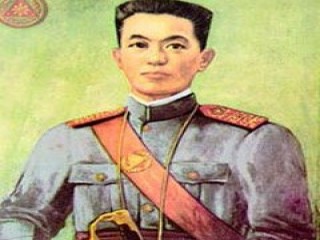
Emilio Aguinaldo biography
Date of birth : 1869-03-23
Date of death : 1964-02-06
Birthplace : Cavite El Viejo, Philippines
Nationality : Filipino
Category : Politics
Last modified : 2011-04-02
Credited as : General and politician, revolutionary,
The Philippine revolutionary leader Emilio Aguinaldo fought for independence of the Philippine Islands, first against Spain and then against the United States.
Born on March 23, 1869, Emilio Aguinaldo grew up in Kawit in Cavite Province and was educated in Manila. Appointed to a municipal position in his home province, he was also the local leader of a revolutionary society fighting Spanish rule over the Philippines. By an agreement signed with rebel leaders in January 1898, Spain agreed to institute liberal reforms and to pay a large indemnity; the rebels then went into exile.
When war broke out between Spain and the United States in April 1898, Aguinaldo made arrangements with the U.S. consuls in Hong Kong and Singapore and with Commodore George Dewey to return from exile to fight against Spain. On June 12 Aguinaldo proclaimed the independence of the Philippine Islands from Spain, hoisted the national flag, introduced a national anthem, and ordered a public reading of the declaration of independence.
When he realized that the United States would not accept immediate and complete independence for the Philippines, he organized a revolution against American rule that resulted in 3 years of bloody guerrilla warfare. He was captured on March 23, 1901, by Gen. Frederick Funston. Funston and several other officers, bound hand and foot, pretended to be prisoners and were taken to Aguinaldo's camp by Filipinos loyal to the United States. Released and given weapons, they easily captured Aguinaldo, who then took an oath of allegiance to the United States and issued a peace proclamation on April 19. The bitterness caused by the war was soon transformed into friendship as Americans and Filipinos joined to work toward Philippine independence. Aguinaldo retired to private life, and his son entered West Point in the same class as Gen. Funston's son.
In 1935 Aguinaldo ran unsuccessfully for president of the Philippine Commonwealth against Manuel Quezon. After the Japanese invasion of the Philippines in 1941, he cooperated with the new rulers, even making a radio appeal for the surrender of the American and Filipino forces on Bataan. He was arrested as a collaborationist after the Americans returned but was later freed in a general amnesty. He explained his action by saying, "I was just remembering the fight I led. We were outnumbered, too, in constant retreat. I saw my own soldiers die without affecting future events. To me that seemed to be what was happening on Bataan, and it seemed like a good thing to stop."
In 1950 he was named to the Council of State, an advisory body for the president, and in his later years he was chairman of a board which dispensed pensions to the remaining veterans of the revolution. He died in Manila on Feb. 6, 1964.
















